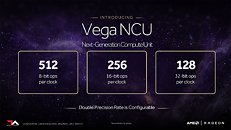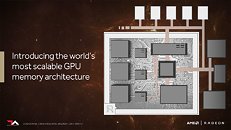Thursday, January 12th 2017

AMD's Vega-based Cards to Reportedly Launch in May 2017 - Leak
According to WCCFTech, AMD's next-generation Vega architecture of graphics cards will see its launch on consumer graphics solutions by May 2017. The website claims AMD will have Vega GPUs available in several SKUs, based on at least two different chips: Vega 10, the high-end part with apparently stupendous performance, and a lower-performance part, Vega 11, which is expected to succeed Polaris 10 in AMD's product-stack, offering slightly higher performance at vastly better performance/Watt. WCCFTech also point out that AMD may also show a dual-chip Vega 10×2 based card at the event, though they say it may only be available at a later date.AMD is expected to begin the "Vega" architecture lineup with the Vega 10, an upper-performance segment part designed to disrupt NVIDIA's high-end lineup, with a performance positioning somewhere between the GP104 and GP102. This chip should carry 4,096 stream processors, with up to 24 TFLOP/s 16-bit (half-precision) floating point performance. It will feature 8-16 GB of HBM2 memory with up to 512 GB/s memory bandwidth. AMD is looking at typical board power (TBP) ratings around 225W.
Next up, is "Vega 20", which is expected to be a die-shrink of Vega 10 to the 7 nm GF9 process being developed by GlobalFoundries. It will supposedly feature the same 4,096 stream processors, but likely at higher clocks, up to 32 GB of HBM2 memory at 1 TB/s, PCI-Express gen 4.0 bus support, and a typical board power of 150W.
AMD plans to roll out the "Navi" architecture some time in 2019, which means the company will use Vega as their graphics architecture for two years. There's even talk of a dual-GPU "Vega" product featuring a pair of Vega 10 ASICs.
Source:
WCCFTech
Next up, is "Vega 20", which is expected to be a die-shrink of Vega 10 to the 7 nm GF9 process being developed by GlobalFoundries. It will supposedly feature the same 4,096 stream processors, but likely at higher clocks, up to 32 GB of HBM2 memory at 1 TB/s, PCI-Express gen 4.0 bus support, and a typical board power of 150W.
AMD plans to roll out the "Navi" architecture some time in 2019, which means the company will use Vega as their graphics architecture for two years. There's even talk of a dual-GPU "Vega" product featuring a pair of Vega 10 ASICs.




187 Comments on AMD's Vega-based Cards to Reportedly Launch in May 2017 - Leak
One year after Pascal. FWIW, a Titan X (not full GP102 core) is 37% faster than a 1080 at 4k Vulkan Doom. It's just when people call Vega's performance stupendous and then repeat such things, it's a bit baity. Once Vega is out it's on a smaller node, has more cores and more compute with more 'superness' than Pascal. So if it doesn't beat Titan X, it's not superb enough frankly.The architecture is a year old.
Although I thought April... but May!? Ouch.
But nothing is set in stone yet, I'm really interested how will this thing perform.
rog.asus.com/forum/showthread.php?90069-Does-Asus-plan-on-releasing-any-other-z270-options-for-mATX-What-about-AM4&p=626123&viewfull=1#post626123
While I don't expect a 1080Ti killer, I anticipate a card that stay in the hunt and project RGT forward focus of there technologies.
Take a look at the review of the TitanX and use the performance summary numbers as a metric.
Look at the Flops numbers over the past few generations and we can do a Performance per Flop (AMD historically has higher theoretical GFLOPS numbers than nVidia for a given performance level).
Do backwards math given that we know Vega is 12 Tflops and AMD averaged 7.6 performances per Teraflop. From there, 91.6% performance vs TitanX.
Actually seems pretty reasonable, so it'll be about where the 1080TI is likely to be and it'll come down to specific optimizations.
*I know this methodology is super hand-wavey. But it gives is another piece of information.
So if we plot out all of these cards as Gflops vs Performance and fit a basic trend line we get that big Vega would be around 80% of Titan performance at 12 TFlops. (this puts it even with the 1080).
So for AMD to be at 1080TI levels, they'll need to have improved their card efficiency by 10 - 15 percent for this architecture.
Given the number of changes they've talked about with this architecture, I don't think that's infeasible but it is a hurdle to overcome.
Also - Is it a driver thing that makes AMD faster in Vulkan API? Or will Nvidia need a brand new architecture in order to catch up with that?
The slide below is from GTC 2015
In 2013, Volta was present but it's HMC design stalled somewhat.
In 2014 (that would be almost 3 years ago, Volta had disappeared from the road map.
In 2015, Volta reappeared and it seems very much for a late 2017 release, though it's far enough to be 2018.
So really, Vega, DX12 etc has got nothing to do with Volta. The memory arrangement affected his position.
Please bear in mind that the only reason Titan X is £1100 is because AMD have NOTHING to touch it with. Nvidia couldn't care less about DX12 and Vulkan for it's GFX cards - their own mid range GP104 (not GP102 and not GP100) is still top dog.
Nvidia by your own definition (a revamped Maxwell masquerading as Pascal) don't even need to try to stay King of Cards.